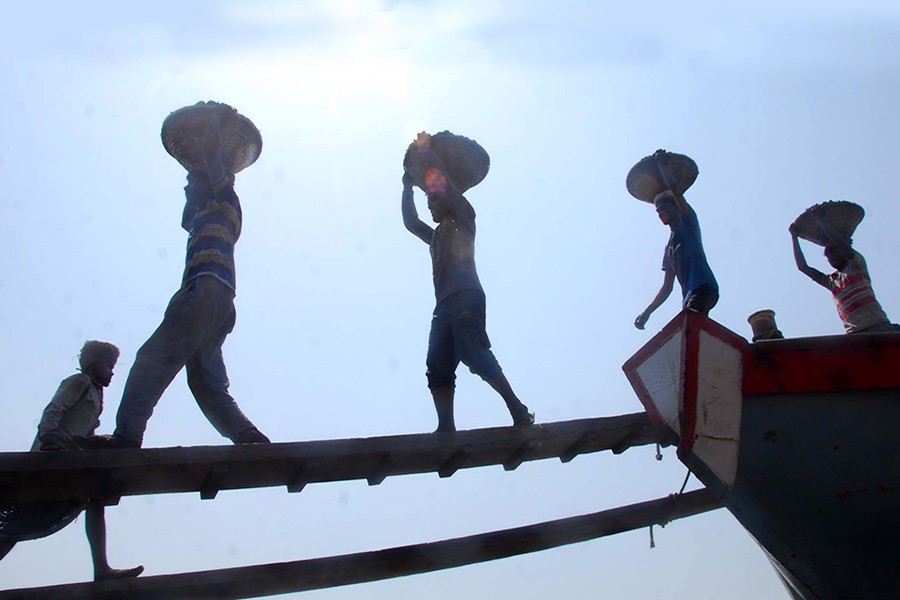The real wage growth in Bangladesh declined to 3.0 per cent in 2017 after showing an upward trend in the previous two consecutive years, according to a latest report of International Labour Organisation (ILO) released on Monday.
The real wage in the country grew by 3.6 per cent and 3.5 per cent respectively in 2016 and 2015.
In 2014, the growth was recorded at 2.4 per cent as compared to 6.2 per cent in 2013, the report titled 'Global Wage Report 2018/19' showed.
The country witnessed 3.4 per cent average real wage growth during the last one decade (2008-17) which was also lower than the regional Southern Asia's growth of 3.7 per cent during the period.
In the region, India achieved the highest 5.5 per cent growth in real wage terms, followed by Nepal 4.7 per cent and Sri Lanka 4.0 per cent respectively during the last decade, according to the report.
The global wage growth in real terms (that is, adjusted for price inflation) has declined from 2.4 per cent in 2016 to just 1.8 per cent in 2017, the ILO report said.
"Global wage growth in 2017 was not only lower than in 2016, but fell to its lowest growth rate since 2008, remaining far below the levels obtaining before the global financial crisis," it read.
The ILO made the report based on data from 136 countries. The report examined the evolution of real wages around the world, giving a unique picture of wage trends globally and by region.
The real wage growth in advanced G20 countries declined to 0.4 per cent in 2017 from 0.9 per cent in 2016, the report revealed.
On the other hand, the growth in emerging and developing G20 countries fluctuated between 4.9 per cent in 2016 and 4.3 per cent in 2017, it added.
"It's puzzling that in high-income economies we see slow wage growth alongside a recovery in GDP growth and falling unemployment. And early indications suggest that slow wage growth continues in 2018," ILO director-general Guy Ryder said in a statement.
Such stagnating wages are an obstacle to economic growth and rising living standards, he said, suggesting that countries should explore, with their social partners, ways to achieve socially and economically sustainable wage growth.
Data analyzing from 70 countries and about 80 per cent of wage employees worldwide the report said that globally women continued to be paid approximately 20 per cent less than men.
The report found that in high-income countries it was at the high end of the pay scale that the gender pay gap was wider, while in low- and middle-income countries the gender pay gap was wider amongst the lower paid workers.
There are wide variations among countries, with the mean hourly gender pay gap, for example, ranging from 34 per cent in Pakistan to 10.3 per cent negative in the Philippines (which would be interpreted to mean that in this country, women earn on average 10.3 per cent more than men), the report read.
"In only one country-Bangladesh - the factor-weighted mean hourly wage gender pay gap is positive," it said.
For almost all countries the gender pay gap is higher when the estimate is based on monthly wages rather than hourly wages, reflecting the fact that in most countries women and men differ significantly in respect of working time -specifically, that part-time work is more prevalent among women than among men.
In all but five of the 73 countries in ILO's database, the incidence of part-time work is higher among women than among men, although the scale of the difference varies widely.
In the Netherlands, for example, 72 per cent of women employees but only 26 per cent of men employees are part-time workers; by contrast, among Bangladeshi employees, only 10 per cent of women and 4 per cent of men work part time.
On a weighted average of the 72 countries, the proportion of women in part-time work is 14 per cent, compared to 7 per cent for men, it showed.
Although there is some variation among countries, it seems that in many countries the gender pay gap widens gradually from the younger to the older cohorts.
"What is also striking is that in all but four of the countries --Australia, Bangladesh, China, Russian Federation-- the gender pay gap is positive at the point of entry into the labour market," the report read.
It showed that mothers tend to have lower wages compared to non-mothers.
"In many countries women are more highly educated than men but earn lower wages, even when they work in the same occupational categories," Rosalia Vazquez-Alvarez, econometrician and wage specialist at the ILO said.
"The wages of both men and women also tend to be lower in enterprises and occupations with a predominantly female workforce. To reduce gender pay gaps more emphasis therefore needs to be placed on ensuring equal pay for women and men, and on addressing the undervaluation of women's work," she said.


